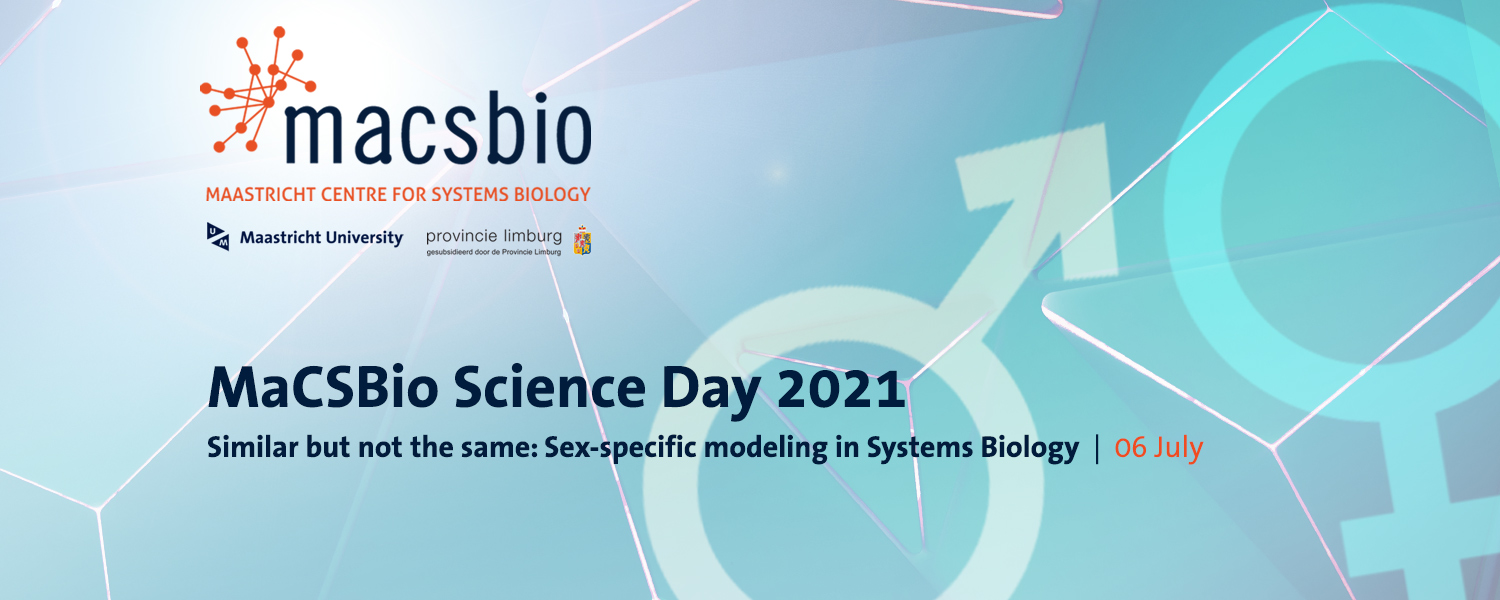MaCSBio Science Day 2021
The theme of this year’s meeting is: Similar but not the same: Sex-specific modeling in Systems Biology.
Our program contains:
- Keynote lecture - Keynote by Anita T. Layton (Professor of Applied Mathematics, Computer Science, Pharmacy, and Biology, University of Waterloo, Canada): His or Her Mathematical Models --- Understanding Sex Differences in Physiology.
- Panel discussion - How to overcome sex and gender bias in technology? A panel discussion led by Aurélie Carlier (Assistant professor MERLN, Maastricht University), co-organised with FEM Maastricht.
- Research - Highlight presentations by MaCSBio researchers and Master students.
- Networking sessions - For students: get to know MaCSBio researchers, teachers and interns and be introduced into research, projects and opportunities in the field of Systems Biology.

Programme
| Time | Presentation/activity |
|---|---|
| 10:00 | Opening and welcome Ilja Arts - Scientific director MaCSBio, Maastricht University |
| 10:10 | Highlight presentations
|
| 10:50 | Break |
| 11:00 |
Systems Biology Master student presentations
|
| 11:45 | Student networking sessions part 1
Networking session conducted by MaCSBio staff and interns to allow students (and others) to be introduced into research, projects and opportunities in the field of Systems Biology |
| 12:30 | Break |
| 14:00 | Keynote lecture: His or Her Mathematical Models - Understanding Sex Differences in Physiology Anita T. Layton - Professor of Applied Mathematics, Computer Science, Pharmacy, and Biology, University of Waterloo, Canada. |
| 15:00 | Break |
| 15:10 | FEM Panel discussion - How to overcome sex and gender bias in technology? A panel discussion Chaired by Aurélie Carlier - Assistant professor MERLN, Maastricht University |
| 15:55 | Closing Ilja Arts |
| 16:00 | Student networking sessions (part 2) and drinks |
| 17:00 | End |
Keynote speaker
Keynote lecture
His or Her Mathematical Models - Understanding Sex Differences in Physiology
Anita T. Layton | Canada 150 Research Chair in Mathematical Biology and Medicine, and Professor of Applied Mathematics, Computer Science, Pharmacy and Biology at the University of Waterloo
Imagine someone having a heart attack. Do you visualise the dramatic Hollywood portrayal of a heart attack, in which a man collapses, grabbing his chest in agony? Even though heart disease is the leading killer of women worldwide, the misconception that heart disease is a men’s disease has persisted. A dangerous misconceptions and risks women ignoring their own symptoms. Gender biases and false impressions are by no means limited to heart attack symptoms. Such prejudices exist throughout our healthcare system, from scientific research to disease diagnosis and treatment strategies.
A goal of our research program is to address this gender equity, by identifying and disseminating insights into sex differences in health and disease, using computational modeling tools.
Abstracts
Deinococcus radiodurans proteome responds rapidly to short-term real microgravity during parabolic flight
As plans for future space exploration are becoming more ambitious, a better understanding of all factors affecting humans, plants, and microorganisms in space is necessary. Microgravity is an important variable in outer space and understanding the short- and long- term effects of microgravity on cellular processes will be important to minimize its negative effects on the physiology of any organism.
Gravitational force has had an important role in the development of life on Earth, and short- and long-term changes in perceived gravitational force can induce notable changes within cells. Deinococcus radiodurans is the gram-positive bacterium that is best known for its extreme resistance to UV-C and gamma radiation, oxidation stress and desiccation, which has led to increased interest in this species in the context of astrobiology.
The present study aimed to elucidate the short-term proteomic response of this species to real microgravity during parabolic flight. Overnight cultures of D.radiodurans were subjected to microgravity during a single parabola, and metabolic activity quenched using methanol on board of parabolic flight. Proteins were extracted and subsequently measured using HPLC ESI MS/MS.
Results indicated multiple affected processes in the cell envelope of D. radiodurans, such as increased peptidoglycan synthesis and altered S-layer activities. Energy metabolism upregulation and increased activity of DNA repair pathways could indicate increased endogenous ROS production that contributes to the stress response.
The present study shows that the D. radiodurans proteome rapidly reacts to real microgravity within 10 2 seconds. Differential expression patterns in response to microgravity show similarities to previously reported stress responses, thus the present results could be used as basis for future research aiming to better understand the complex regulatory processes underpinning stress management in D. radiodurans.
Identifying the key pathways involved in a pearl-necklace like mitochondrial phenotype
Mitochondria are dynamic organelles that are responsible for the production of ATP. Mitochondrial dynamics are processes that allow the organelles to adapt their morphology according to the cellular energy demands.
Fission and fusion are essential processes that regulate the number of healthy mitochondria in the cell. Defects in these processes have been linked to diseases such as Alzheimer and Charot-Marie Tooth. Investigating and identifying key factors involved in mitochondrial dynamics defects will increase our understanding of the organelle’s role in disease. The host research team observed an altered mitochondrial phenotype, resembling a pearl-necklace shape, upon knockdown of fission genes in fibroblast cells that has not been previously reported and did not emerge in HeLa, HEK293T, HUVEC and HepG2 cells.
The current study constitutes a novel computational approach to identify pathways involved in this phenotype. To do so, RNAseq data from the before mentioned cell types were obtained and average gene expression (average FPKM) of each cell type was calculated to compare differences between the cell types in baseline pathway activity level. Moreover, the methodological approach included differentially expressed gene analysis in combination with pathway enrichment and network analysis to compare differences between the cell types in pathway level. Candidate pathways will be selected based on their involvement in the pearl-necklace phenotype. Validation of the candidate pathways will be conducted in the wet lab if Covid-19 measures allow for.
Expected results will confirm the hypothesis that the phenotype is tissue specific, hence provide additional knowledge on the tissue specificity of mitochondrial diseases.
-
Ariadna Fosch i MuntanéPredicting the effect of contact-tracing apps in epidemic spreading: A multilayer network approach
-
Karlis MoorsDeinococcus radiodurans proteome responds rapidly to short-term real microgravity during parabolic flight
-
Rita SarantidouIdentifying the key pathways involved in a pearl-necklace like mitochondrial phenotype
